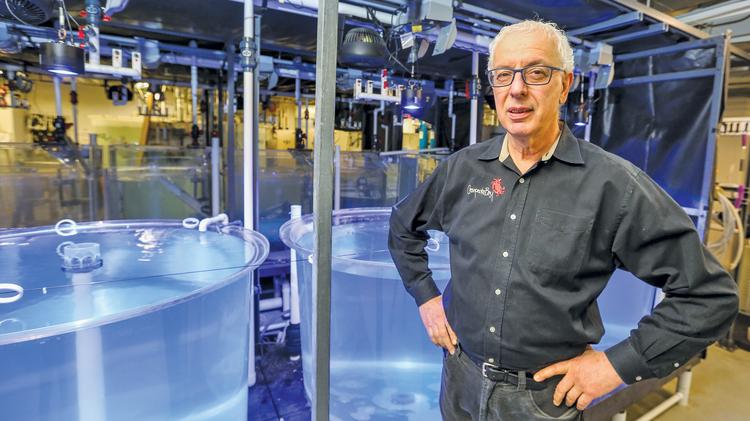Progress on Blue Fin Tuna Aquaculture
From the Baltimore Business Journal:
At the Institute of Marine and Environmental Technology, Yonothan Zohar and a tea of researchers are involved in a bold experiment. Their mission: Invent bluefin tuna farming.
The bluefin tuna is an impressive beast, capable of swimming entire oceans, growing upwards of 600 pounds, and living up to 40 years.
But the bluefin, prized by chefs and savored by sushi lovers, has been dramatically over-fished during the last half-century and is "in danger of being depleted from the ocean," said Zohar, who is also chairman of the Department of Marine Biotechnology at the University of Maryland, Baltimore County.
At the IMET, Zohar's team is working on raising bluefin tuna in captivity. Using bluefin tuna eggs they receive from Kali Tuna, a Croatian company, Zohar's team at the IMET is working on raising bluefin tuna from their earliest stages as an egg.

Katlin Newman - Yonathan Zohar, the chairman of the Department of Marine Biotechnology at the University of Maryland, Baltimore County, and his team are the first people ever to grow bluefin tuna in capativity.
Their goal: Grow tuna, from the larvae to adult stage. It’s a method of
aquaculture that, if successful, would simultaneously satiate the world’s hunger and protect the rapidly diminishing wild supply of the mighty bluefin.
What does it mean to “farm” bluefin tuna? We’re trying to develop technologies to enable the production of high-value marine fish through aquaculture. The idea is to make marine aquaculture a sustainable industry to reduce our dependence on wild stocks. Tuna is our holy grail. Tuna is a fish that has been largely and strongly overfished in the marine environment. It’s what motivated many of us around the world to start developing aquaculture technologies to be able to raise bluefin tuna in captivity. You have to get the fish to spawn and to start producing juveniles. The first hurdle was to get bluefin tuna to spawn in captivity.
So Kali Tuna in Croatia keeps the IMET’s breeding stock of bluefin tuna — the big, 500-pound fish — in floating net pens. The males and females are right next to each other. So why do you say it’s a hurdle to get bluefin tuna to spawn in captivity? Because commercially important fin fish do not reproduce when they are being held in captivity. For years I worked on developing technologies to induce commercially important marine fish to spawn in captivity. We located it to one hormone in the brain that jumpstarts their reproductive process. So for our colleagues in Croatia, we produced for them implants they mount on the arrowheads of spear guns, and they use divers to shoot into the bluefin tuna biodegradable, hormonal implants. These induced fish successfully spawn millions and millions of eggs, usually a few hours before sunrise. They collect the eggs, clean them, and ship them to Baltimore. We receive them, and this is when we start the race toward growing them into juveniles.
A National Public Radio report from 2014 noted that your team had been able to raise bluefin tuna in captivity up to about 30 days old. Any progress on keeping them alive longer? The bottleneck was always the first 25 to 30 days, and this year we were able to open that bottleneck. We had bluefin juveniles that were about 60 to 70 days of age. Between four and six inches in length are our largest fish.
How do you get bluefin tuna in captivity to grow up to 60 days? The main work is to be able to develop a feeding protocol. Tuna larvae, once they hatch from eggs, are different from any other fish species because tuna is a fish that grows so fast. They had to be fed a diet that would mimic what they eat in the wild, which we don’t know exactly, and because tuna grow so fast they had to be fed with different types of live organisms at very high densities. And every few days you have to change the prey you offer them. And tuna, unlike any other fish, needs to be fed with the larvae of other marine fish species, which complicates it a lot. But this is what will drive them into 25 to 30 days of survival. At that point you start to wean them off live diets. Then you start to feed them on an artificial, powdered feed formulation.
What might a larger, future farming operation look like? The vision is to
somehow partner with industry, and to move the fish to much larger tanks or
floating net pens in the ocean. If we want to grow the juveniles in tanks, the
tanks would probably be about 36 feet in diameter and maybe 12 feet deep. And I don’t think necessarily we have to grow bluefin tuna for consumption for the market to 400 or 500 pounds. We can grow them to 50 pounds.
Posted: February 19, 2016, 3:02 PM